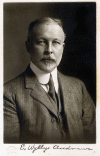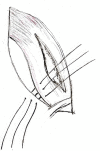A "New" Nonmesh Technique for Inguinal Hernia Repair: Revisiting E. Wyllys Andrews and His Imbricating Operation
- PMID: 37746612
- PMCID: PMC10513125
- DOI: 10.1097/AS9.0000000000000310
A "New" Nonmesh Technique for Inguinal Hernia Repair: Revisiting E. Wyllys Andrews and His Imbricating Operation
Abstract
The use of prosthetic mesh to repair inguinal hernias has been common practice at surgical centers around the world for more than 30 years. Open tissue repairs are the alternative for patients who cannot have, do not want, or are not offered mesh. Open tissue repairs are troubled by inferior recurrence rates in most clinical trials. In this article, we will review a long-forgotten tissue repair described by Andrews in 1895. In addition, we report on our early experience with the Andrews technique for primary inguinal hernia tissue repair.
Copyright © 2023 The Author(s). Published by Wolters Kluwer Health, Inc.
Figures





Similar articles
-
Preliminary results of a two-layered prosthetic repair for recurrent inguinal and ventral hernias combining open and laparoscopic techniques.Hernia. 2006 Jun;10(3):253-7. doi: 10.1007/s10029-006-0085-3. Epub 2006 Apr 12. Hernia. 2006. PMID: 16609818
-
Long-term Recurrence and Complications Associated With Elective Incisional Hernia Repair.JAMA. 2016 Oct 18;316(15):1575-1582. doi: 10.1001/jama.2016.15217. JAMA. 2016. PMID: 27750295
-
Recurrent inguinal hernia: preferred operative approach.Am Surg. 1998 Jun;64(6):569-73; discussion 573-4. Am Surg. 1998. PMID: 9619180
-
[Tension-free procedures in the surgical treatment of groin hernias].Srp Arh Celok Lek. 2003 Jan-Feb;131(1-2):82-91. doi: 10.2298/sarh0302082m. Srp Arh Celok Lek. 2003. PMID: 14608870 Review. Serbian.
-
Inguinal hernia: an old condition with new solutions.Ann Surg. 2003 Dec;238(6 Suppl):S148-57. doi: 10.1097/01.sla.0000097796.63010.e8. Ann Surg. 2003. PMID: 14703756 Review.
References
-
- Corbitt JD, Jr. Laparoscopic herniorrhaphy. Surg Laparosc Endosc. 1991;1:23–25. - PubMed
-
- Collaboration ET. Mesh compared with non-mesh methods of open groin hernia repair: systematic review of randomized controlled trials. Br J Surg. 2000;87:854–859. - PubMed
-
- Beard JH, Thet Lwin ZM, Agarwal S, et al. . Cost-Effectiveness analysis of inguinal hernia repair with mesh performed by surgeons and medical doctors in Ghana. Value Health Reg Issues. 2022;32:31–38. - PubMed
LinkOut - more resources
Full Text Sources

